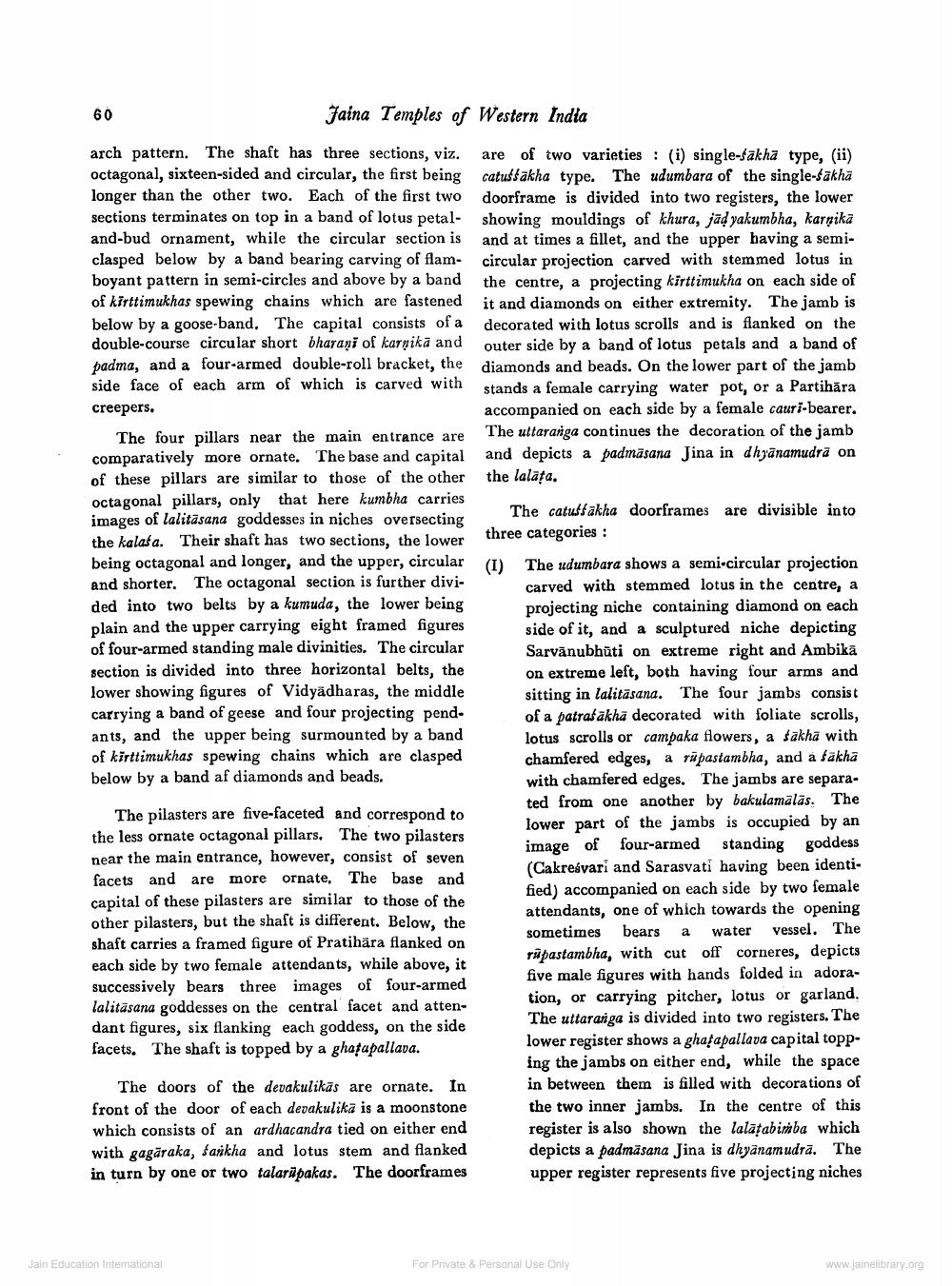________________
60
Jaina Temples of Western India
arch pattern. The shaft has three sections, viz. are of two varieties : (i) single-sakha type, (ii) octagonal, sixteen-sided and circular, the first being catussakha type. The udumbara of the single-fakha longer than the other two. Each of the first two doorframe is divided into two registers, the lower sections terminates on top in a band of lotus petal- showing mouldings of khura, jād yakumbha, karnika and-bud ornament, while the circular section is and at times a fillet, and the upper having a semiclasped below by a band bearing carving of flam- circular projection carved with stemmed lotus in boyant pattern in semi-circles and above by a band the centre, a projecting kirttimukha on each side of of kirttimukhas spewing chains which are fastened it and diamonds on either extremity. The jamb is below by a goose-band. The capital consists of a decorated with lotus scrolls and is flanked on the double-course circular short bharaṇi of karņikā and outer side by a band of lotus petals and a band of badma, and a four-armed double-roll bracket, the diamonds and beads. On the lower part of the jamb side face of each arm of which is carved with stands a female carrying water pot, or a Partihāra creepers.
accompanied on each side by a female cauri-bearer. The four pillars near the main entrance are The ultaranga continues the decoration of the jamb comparatively more ornate. The base and capital and depicts a padmāsana Jina in dhyānamudrä on of these pillars are similar to those of the other the lalafa. octagonal pillars, only that here kumbha carries
The catusfākha doorframes are divisible into images of lalitāsana goddesses in niches oversecting the kalasa. Their shaft has two sections, the lower
three categories : being octagonal and longer, and the upper, circular (1) The udumbara shows a semi-circular projection and shorter. The octagonal section is further divi
carved with stemmed lotus in the centre, a ded into two belts by a kumuda, the lower being
projecting niche containing diamond on each plain and the upper carrying eight framed figures
side of it, and a sculptured niche depicting of four-armed standing male divinities. The circular Sarvānubhüti on extreme right and Ambika section is divided into three horizontal belts, the on extreme left, both having four arms and lower showing figures of Vidyadharas, the middle sitting in lalitäsana. The four jambs consist carrying a band of geese and four projecting pend. of a patrafakha decorated with foliate scrolls, ants, and the upper being surmounted by a band lotus scrolls or campaka flowers, a $akha with of kirttimukhas spewing chains which are clasped
chamfered edges, a rūpastambha, and a fakha below by a band af diamonds and beads.
with chamfered edges. The jambs are separa
ted from one another by bakulamalas. The The pilasters are five-faceted and correspond to
lower part of the jambs is occupied by an the less ornate octagonal pillars. The two pilasters
image of four-armed standing goddess near the main entrance, however, consist of seven facets and are more ornate. The base and
(Cakresvari and Sarasvati having been identicapital of these pilasters are similar to those of the
fied) accompanied on each side by two female other pilasters, but the shaft is different. Below, the
attendants, one of which towards the opening
sometimes bears a water vessel. The shaft carries a framed figure of Pratihära flanked on
rūpastambha, with cut off corneres, depicts each side by two female attendants, while above, it
five male figures with hands folded in adorasuccessively bears three images of four-armed
tion, or carrying pitcher, lotus or garland. lalitäsana goddesses on the central facet and attendant figures, six flanking each goddess, on the side
The uttaranga is divided into two registers. The facets. The shaft is topped by a ghafapallava.
lower register shows a ghafapallava capital topp
ing the jambs on either end, while the space The doors of the devakulikās are ornate. In in between them is filled with decorations of front of the door of each devakulika is a moonstone the two inner jambs. In the centre of this which consists of an ardhacandra tied on either end register is also shown the lalatabimba which with gagäraka, Sarikha and lotus stem and flanked depicts a padmasana Jina is dhyanamudra. The in turn by one or two talaripakas. The door frames upper register represents five projecting niches
Jain Education International
For Private & Personal Use Only
www.jainelibrary.org




